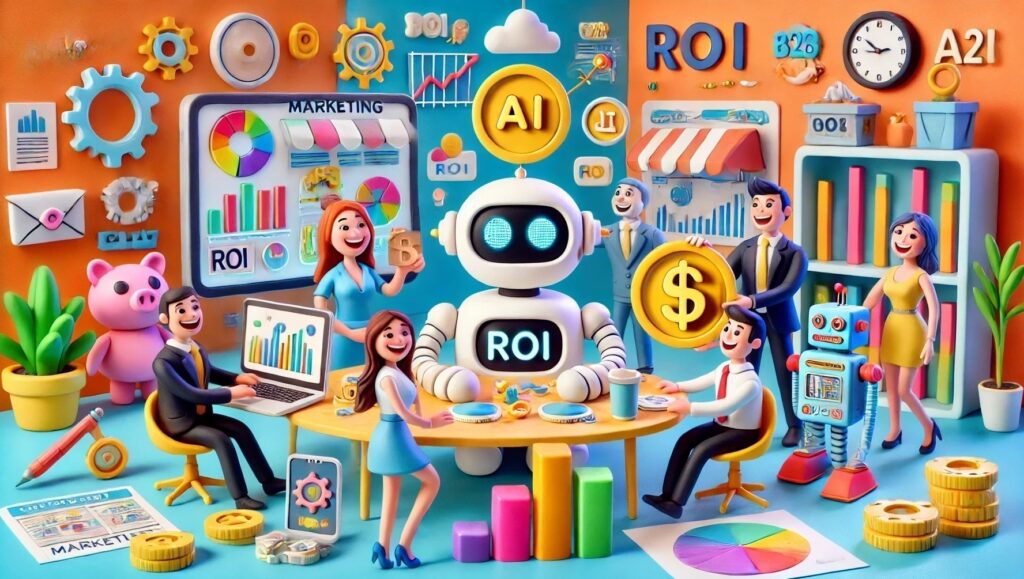The 6 Critical Metrics for Measuring Generative AI ROI in B2B Marketing
Beyond the Hype: Real ROI from Generative AI in B2B Marketing Blog Series
Welcome back to our series on harnessing the ROI of generative AI in B2B marketing. In our previous installments, we’ve explored the fundamentals of generative AI, traced its evolution, delved into practical applications, and provided guidance on integrating it into your marketing strategy. Now, we’re diving deep into one of the most critical aspects: measuring generative AI’s return on investment (ROI). Understanding and demonstrating the value of your AI initiatives is beneficial and essential for sustaining and scaling your efforts in the competitive B2B landscape.
Defining ROI for AI Initiatives: Beyond the Basics
Before we explore specific metrics and methods, it’s crucial to understand ROI in the context of generative AI. While ROI traditionally measures the financial benefit from an investment relative to its cost, it takes on a more nuanced meaning in AI. In B2B marketing, this involves evaluating how AI-driven efforts impact your bottom line through increased revenue, reduced costs, or both—but it also encompasses less tangible benefits like improved brand perception, enhanced customer experience, and increased operational efficiency.
Aligning AI Projects with Business Objectives: The Foundation of Success
Aligning your AI initiatives with clear business objectives is crucial for an accurate ROI measurement. These could range from increasing lead generation and improving conversion rates to enhancing customer satisfaction, productivity, workplace commutation and efficiencies, or operational costs. By linking AI projects directly to clear objectives, you can more easily quantify their impact and justify continued investment.
Slack has been actively integrating AI features into its platform to enhance productivity and improve user experience. The company has introduced several AI-powered tools, such as channel recaps, thread summaries, and an advanced search function. These features help users save time by quickly accessing relevant information and staying up-to-date with conversations. Slack’s AI initiatives focus on leveraging institutional knowledge within organizations, making it easier for employees to find and utilize information efficiently. The emphasis is streamlining workflows and enabling more competent work practices rather than reducing content creation costs. By implementing these AI-driven features, Slack aims to boost overall productivity and make collaboration more effective for its users, aligning with its core mission of improving workplace communication and efficiency.
Consider setting SMART (Specific, Measurable, Achievable, Relevant, Time-bound) goals for each AI initiative. This approach ensures that your objectives are concrete and trackable, making ROI measurement more straightforward and meaningful. For instance, a SMART goal for an AI-driven lead generation campaign could be to increase qualified leads by 20% within the next six months.
The 6 Critical Metrics for Measuring ROI: A Comprehensive Approach
Identifying the right metrics is crucial for evaluating the success of your AI initiatives. Here are some key metrics to consider, along with additional insights and examples:
- Cost Savings
One of the most straightforward ways to measure ROI is by calculating cost savings. This includes reductions in labor costs, content production expenses, and other operational efficiencies gained through automation. The potential for significant cost savings should inspire optimism about AI’s financial benefits.
The implementation of generative AI in B2B marketing has shown promising results regarding return on investment (ROI) and cost savings. According to a Statista study, approximately 4% of companies experienced at least 20% cost savings after adopting AI. In comparison, 28% reduced their costs by 10% or less. In the marketing and sales sector, around 20% of teams reported cost reductions between 10% and 19% following AI implementation. These figures not only highlight the potential for significant financial benefits from integrating AI into marketing strategies but also inspire optimism about the financial benefits of AI.
A compelling example of AI-driven efficiency in content marketing comes from The New York Times. By leveraging generative AI for headline testing, the publication automated a previously manual process of A/B testing headlines to optimize engagement. This approach saved time and resources and provided data-driven insights for creating more effective headlines. While specific cost figures weren’t disclosed, this case illustrates how AI can streamline content-related processes, potentially leading to substantial time and resource savings in B2B marketing efforts. Furthermore, a widely cited statistic suggests that for every $1 invested in AI, companies realize an average ROI of $3.50. This impressive return underscores the economic potential of generative AI in B2B marketing, positioning it as a powerful tool for enhancing productivity and driving cost-effective content creation strategies.
Consider tracking not just direct cost savings but also opportunity costs. For instance, if your team can now focus on high-value tasks instead of routine content creation, calculate the value of this freed-up time. This could include the potential revenue from new high-value tasks or the cost savings from not having to outsource these tasks.
- Revenue Growth
Generative AI has emerged as a powerful tool for enhancing marketing effectiveness and driving revenue growth. Companies can significantly improve their marketing outcomes by leveraging AI-driven campaigns and personalized content creation. A compelling example comes from Dell Technologies, which implemented generative AI solutions to boost the effectiveness of its marketing communications. Through feeding large datasets of customer information into AI-powered language optimization tools, Dell transformed their content creation process. This allowed their team to produce more engaging, targeted messages that matched unique prospects’ needs. The results were impressive:
– 59% increase in email campaign click-through rates (CTR)
– 79% rise in conversions
– 24% higher Facebook ad CTR and doubled conversion rates
These metrics demonstrate generative AI’s potential to enhance marketing effectiveness and drive revenue growth. To track the impact of AI-driven marketing initiatives, companies should focus on key performance indicators (KPIs) such as lead generation, conversion rates, and sales growth attributable to AI campaigns. By consistently monitoring these metrics, businesses can gain confidence in AI’s marketing effectiveness and its role in revenue growth.
Furthermore, research indicates that businesses investing in AI are experiencing revenue increases ranging from 3% to 15% and improvements in sales return on investment (ROI) of 10% to 20%. These figures underscore the significant potential of generative AI to drive tangible business results when applied strategically to marketing efforts.
Remember to look beyond immediate revenue gains. Consider tracking the lifetime value of customers acquired through AI-driven campaigns compared to traditional methods. This can provide a more comprehensive view of AI’s long-term impact on revenue.
- Engagement Metrics
Improved engagement is often a leading indicator of future revenue growth. Track metrics like click-through rates (CTR), time spent on content, and social media engagement to gauge the impact of AI-generated content. Engagement metrics serve as crucial indicators of the effectiveness of AI-generated content in marketing strategies. Studies have shown promising results regarding improved engagement when using AI-powered tools.
For example, Dell Technologies reported significantly boosting its email campaign performance after implementing AI-generated content. They saw a 59% increase in click-through rates (CTR) and a 79% rise in conversions. Their Facebook ad CTR also doubled, and conversion rates increased by 24%.
These metrics demonstrate the potential of AI to enhance content relevance and appeal to target audiences. Time spent on content is another valuable metric for assessing engagement. While specific data on this metric for AI-generated content is limited, the overall trend suggests that well-crafted, personalized content keeps users engaged for longer. Social media engagement, including likes, shares, and comments, can also provide insights into how AI-generated content resonates with audiences. As companies continue to refine their AI content strategies, tracking these engagement metrics will be crucial in determining the ROI of AI implementation and its impact on future revenue growth.
Dive deeper into engagement metrics by analyzing the quality of interactions. For instance, track the number of meaningful comments or shares on social media posts, not just likes or views. This can provide insights into the depth of engagement AI-generated content is fostering.
- Customer Satisfaction
Enhancing customer experience through personalized content and responsive interactions can increase satisfaction and loyalty. Use Net Promoter Scores (NPS), customer feedback, and retention rates to measure this impact. Consider implementing AI-powered sentiment analysis on customer feedback to automatically categorize and prioritize areas for improvement.
Personalization can take many forms, from customized product recommendations to targeted marketing messages and individualized support interactions. For instance, AI-enabled chatbots and Intelligent Virtual Assistants (IVAs) can provide quick, accurate responses to customer queries, often resolving issues without human intervention. This improves response times and allows customers to access support 24/7, enhancing their overall experience.
Additionally, AI can analyze customer data to identify patterns and preferences, enabling businesses to proactively offer relevant products, services, or support, increasing satisfaction.
In addition, consider implementing sentiment analysis on customer interactions with AI-generated content or AI-powered systems. This can provide nuanced insights into customer satisfaction beyond traditional metrics.
- Content Quality and Consistency
While often overlooked, the quality and consistency of AI-generated content can significantly impact your overall marketing effectiveness. Implement a system to rate content quality and track improvements over time. Develop a scoring rubric that evaluates content based on predefined criteria such as relevance, accuracy, coherence, and alignment with brand voice. This could include factual accuracy, grammar and style consistency, relevance to the target audience, and adherence to brand guidelines. By regularly applying this rubric to AI-generated content, marketers can quantify quality improvements and identify areas needing refinement.
Additionally, incorporating human review alongside automated checks can provide a more comprehensive assessment of content quality and consistency. This hybrid approach allows for nuanced evaluation of factors that may be challenging for AI to assess, such as tone and cultural sensitivity. Marketers can consistently monitor these metrics to ensure that AI-generated content meets high standards and effectively supports overall marketing objectives. When discussing our relevance as marketers and the fact that generative AI still requires human intervention, this is a perfect use case where the human marketer excels. It is the combination of humans plus machines that shines.
- Time-to-Market
AI can significantly accelerate content creation and campaign deployment. Track the reduction in time-to-market for your marketing initiatives. AI has emerged as a game-changer in accelerating content creation and campaign deployment, significantly reducing time-to-market for marketing initiatives.
By leveraging AI-powered tools and automation, marketers can streamline workflows and produce high-quality content at unprecedented speeds. For instance, AI can generate initial drafts of blog posts, social media content, and email campaigns, allowing human marketers to focus on refining and personalizing the output. This collaborative approach between AI and human creativity can dramatically reduce the time required for content ideation and creation.
Moreover, AI’s ability to analyze vast amounts of data and provide real-time insights enables marketers to make faster, data-driven decisions about campaign strategies and targeting. Machine learning algorithms can quickly identify trends, predict audience preferences, and optimize campaign parameters, allowing for rapid deployment and iteration of marketing campaigns.
By tracking metrics such as content creation speed, campaign deployment time, and overall time-to-market for campaigns, organizations can quantify the impact of AI on their marketing efficiency. Reducing these timeframes allows companies to be more responsive to market trends. It provides a competitive edge by enabling them to capitalize on opportunities more quickly than their competitors.
Final Thoughts: Charting the AI-Powered Future of B2B Marketing
As we’ve explored throughout this article, measuring the ROI of generative AI in B2B marketing is more than a financial exercise—it’s a strategic imperative. By harnessing the power of AI, marketers can unlock unprecedented levels of personalization, efficiency, and effectiveness in their campaigns. The key to success lies in a holistic approach: setting clear objectives, tracking comprehensive metrics, and embracing a culture of continuous optimization.
The journey of AI integration in B2B marketing is just beginning. As we stand on the cusp of a new era, emerging technologies promise to further revolutionize our field. From advanced natural language processing that crafts hyper-personalized content to predictive analytics that anticipates market trends with uncanny accuracy, the future of AI in marketing is boundless.
What’s Next: Peering into the AI Crystal Ball
In our upcoming blogs in this series, we’ll explore the cutting-edge innovations shaping the future of generative AI in B2B marketing. We’ll explore leveraging predictive analytics to optimize AI-driven marketing strategies, how quantum computing could supercharge our data processing capabilities, examine the potential of AI-driven virtual reality experiences in B2B sales, and finally wrap-up with a discussion around the ethical considerations of increasingly sophisticated AI systems.
As AI continues to evolve, so must our strategies for harnessing its power. We’ll investigate how these emerging technologies might reshape ROI calculations and explore new metrics that could become crucial in the AI-driven marketing landscape of tomorrow.
Your insights and experiences are invaluable as we navigate this exciting frontier together. Have you implemented AI in your B2B marketing efforts? What challenges have you faced in measuring its ROI? Share your thoughts in the comments below—let’s foster a community of innovation and learning in this rapidly evolving field.
Stay tuned for our next installment, where we’ll peer into the future of AI-powered B2B marketing through predictive analytics. Until then, keep pushing the boundaries of what’s possible in your AI marketing initiatives. The future is here, and it’s brilliantly intelligent!
*This blog post is a collaborative effort between my insights and the capabilities of generative AI, blending human experience with advanced technology. Image created by DALL-E



